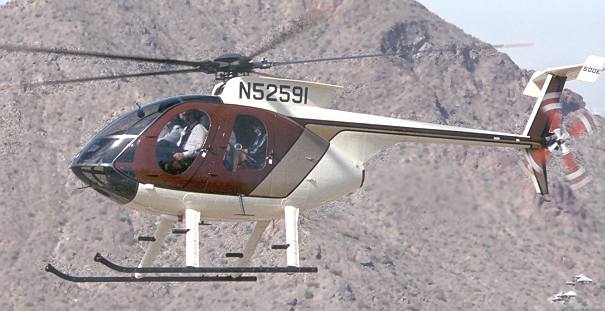| Picture |

|
| Manufacturer |
McDonnell Douglas
|
| Type |
MD500E
|
| Introduced |
1/1/1976
|
| In production? |
Yes
|
| Units produced |
4700
|
| Price US $ |
1,500,000.00
|
| Overall Length |
30.8 ft
|
| Length |
24.6 ft
|
| Height |
9.8 ft
|
| Width |
4.6 ft
|
| |
|
| |
|
| Description |
The story of the MD500 series starts back in 1960 when the US Army issued a Technical Specification 153 for a Light Observation Helicopter (LOH). Twelve companies participated in this competition, and the designs of Bell and Hiller were selected. However, subsequently, and to the surprise of these two companies, Hughes was later readmitted to the process with its Model 369 design, ultimately winning the bid based on its superior technical specifications and a very low price per unit.
The Hughes 369 (nicknamed the 'flying egg') was known by the army as the OH-6A Cayuse /Loach. Hughes also developed a civilian version, which was the start of the Hughes 500-series, whose designation was changed into MD500 after the acquisition of Hughes by McDonnell Douglas in January 1984.
The design of the MD500 has some technological innovations worth mentioning. The first is the construction of the fully articulated rotor head based on flexible strap packs that connect the four rotor blades to the rotor shaft. This rigid type of rotor head eliminates the need for pitch bearings and flap hinges, thus saving weight and reducing maintenance costs. The egg-shaped fuselage makes the MD500 very good aerodynamically.
Both the military version and the civilian MD500 series were very successful due to the versatility of this light helicopter.
The MD500E is a light, five-seater turbine engine helicopter, which uses a five-bladed main rotor system.
|
| Advertisement |
|
| Design features |
- Mechanical controls without hydraulic boost
- Aluminum main rotor blades
- Tubular skids carried on oleo-pneumatic shock-absorbers
- Longer and more streamlined nose
|
The story of the MD500 series starts back in 1960 when the US Army issued a Technical Specification 153 for a Light Observation Helicopter (LOH). Twelve companies participated in this competition, and the designs of Bell and Hiller were selected. However, subsequently, and to the surprise of these two companies, Hughes was later readmitted to the process with its Model 369 design, ultimately winning the bid based on its superior technical specifications and a very low price per unit.
The Hughes 369 (nicknamed the 'flying egg') was known by the army as the OH-6A Cayuse /Loach. Hughes also developed a civilian version, which was the start of the Hughes 500-series, whose designation was changed into MD500 after the acquisition of Hughes by McDonnell Douglas in January 1984.
The design of the MD500 has some technological innovations worth mentioning. The first is the construction of the fully articulated rotor head based on flexible strap packs that connect the four rotor blades to the rotor shaft. This rigid type of rotor head eliminates the need for pitch bearings and flap hinges, thus saving weight and reducing maintenance costs. The egg-shaped fuselage makes the MD500 very good aerodynamically.
Both the military version and the civilian MD500 series were very successful due to the versatility of this light helicopter.
The MD500E is a light, five-seater turbine engine helicopter, which uses a five-bladed main rotor system.
|
|
- Advertisement -
|
Design features:
- Mechanical controls without hydraulic boost
- Aluminum main rotor blades
- Tubular skids carried on oleo-pneumatic shock-absorbers
- Longer and more streamlined nose
|
| Persons |
5
|
| Max. Range |
275 mi
|
| Cruise Speed |
155 mph
|
| Max. Speed |
175 mph
|
| Max. rate of Climb |
1770 ft/min
|
| HOGE ceiling |
6000 ft
|
| Service Ceiling |
16000 ft
|
| Gross Weight |
3000 lb
|
| Empty Weigt |
1481 lb
|
| Useful Load |
1519 lb
|
| Fuel Capacity |
64 gallons
|
| Number of Engines |
1
|
| Engine Type |
Turbine
|
| Engine Code |
Allison 250-C20B
|
| Horse Power |
420
|
| Rotorhead |
|
| Number of rotorblades |
5
|
| Rotor Diameter |
26.4 ft
|
| Number of tail rotorblades |
2
|
| Tailrotor Diameter |
4.6 ft
|
|